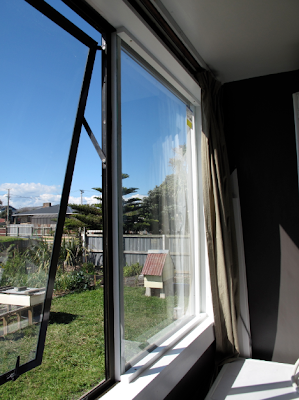I’ve been writing a lot about warm, low-energy, healthy
homes lately, so I’ve decided to change things up for a mid-winter’s break and
write about summery things like yard and garden. For us, the outdoor
“renovation” of our weed-infested section has been as significant as the
passive solar redesign of our old villa. We have used most of the same design
thinking in both cases, and strive to create systems that both save money and a
have low impacts on the environment.
Crediting my lovely and brilliant wife with coining the term
‘eco-thrifty’, I have no better way to describe what we have accomplished on
our vast holdings of 700 metres squared: a carbon-neutral (well, actually we
store carbon), regenerative (getting better, ie healthier, every season) and
productive (ie, kai) landscape.
Boy, that was a lot of information after the colon. Let’s
dissect it piece by piece.
Our lawn, 3rd March 2013, after 3 months of summer drought.
Castlecliff Reserve, 3rd March 2013, after 3 months of summer drought.
50 meters from our lawn, pictured above.
Carbon-Neutral. Not that it is a big accomplishment, but we
manage our 700 square metre section without the use of a mower. At the risk of
offending some readers, I’ll put the next point as delicately as possible: In
my opinion, petrol mowers are neither eco and nor thrifty. They cost money to
buy. They cost money to run. They cost money to repair. They create noise
pollution and air pollution. Just my opinion.
Regenerative. We take a holistic management view of our
section wherein we retain about a third of it in grass, but avoid the use of a
mower by using chooks and ducks to ‘work’ for us on a seasonal basis. During
the colder months – roughly May through August – we ‘tractor’ our fowl across
our lawn. You may have heard of a ‘chicken tractor’ before, but trust me, they
work just as well for ducks.
If you haven’t heard of a chicken tractor, its just a mobile
chook pen, and if I have communicated well with my editor there just may be a
picture of one somewhere on this page. As an aside, one of my favorite all-time
discoveries is Google Image Search. Type in ‘chicken tractor’ and see what you
get!
Rosemary, Amelia and Eunice.
As the chooks and ducks graze the grass, they stimulate root
growth, which makes most grasses healthier. Additionally, their poos fertilize
the grass and make it healthier still. These healthier grasses out-compete the
opportunistic weeds that once thrived in our poor, dry, sandy soils. The more
we have tractored the birds, the healthier the grasses have become, which then
are even healthier for the birds to eat. This type of a positive ‘upward
spiral’ is often called regenerative.
Productive. To go ‘old school’ on you for a moment, almost
every square inch of our property
contributes to the growing of food. How, you may ask, can that be when I’ve
already stated that a third of it is in grass. Well, sure, the chooks and ducks
eat some grass, but all of them prefer layer pellets. As you would.
More significantly, we grow our own mulch on our property.
As mentioned above, tractoring the birds across the lawn for five cold months a
year improves the health of the grasses. But we do not want to be stepping in
duck poo all summer long. For the seven warmer months, we let the grass grow
for three to four weeks at a time and then cut it with a scythe. The cut grass
is dried and then used to mulch our vege gardens. It’s all part of ‘the circle
of life.’ Hakuna matata, bro.
Want to learn more? Check out these upcoming workshops:
The Carbon-Neutral Lawn: 13th July, 3-4 pm, or 14th
July, 3-4 pm.
How to REALLY Compost: 13th July, 4-5 pm, or 14th
July, 4-5 pm






























